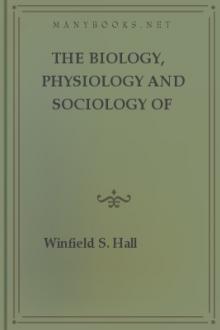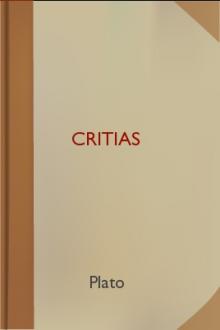Illusions, James Sully [speld decodable readers .TXT] 📗

- Author: James Sully
- Performer: -
Book online «Illusions, James Sully [speld decodable readers .TXT] 📗». Author James Sully
The connection between the illusory side of our life and insanity may be seen in another way. All illusion has as its negative condition an interruption of the higher intellectual processes, the due control of our mental representations by reflection and reason. In the case of passive illusions, the error arises from our inability to subordinate the suggestion made by some feature of the present impression to the result of a fuller inspection of the object before us, or of a wider reflection on the past. In other words, our minds are dominated by the partial and the particular, to the exclusion of the total or the general. In active illusions, again, the powers of judgment and reflection, including those of calm perception itself, temporarily vacate their throne in favour of imagination. And this same suspension of the higher intellectual functions, the stupefaction of judgment and reflection made more complete and permanent, is just what characterizes insanity.
We may, perhaps, express this point of connection between the illusions of normal life and insanity by help of a physiological hypothesis. If the nervous system has been slowly built up, during the course of human history, into its present complex form, it follows that those nervous structures and connections which have to do with the higher intellectual processes, or which represent the larger and more general relations of our experience, have been most recently evolved. Consequently, they would be the least deeply organized, and so the least stable; that is to say, the most liable to be thrown hors de combat. This is what happens temporarily in the case of the sane, when the mind is held fast by an illusion. And, in states of insanity, we see the process of nervous dissolution beginning with these same nervous structures, and so taking the reverse order of the process of evolution.[67] And thus, we may say that throughout the mental life of the most sane of us, these higher and more delicately balanced structures are constantly in danger of being reduced to that state of inefficiency, which in its full manifestation is mental disease.
Does this way of putting the subject seem alarming? Is it an appalling thought that our normal mental life is thus intimately related to insanity, and graduates away into it by such fine transitions? A moment's reflection will show that the case is not so bad as it seems. It is well to remind ourselves that the brain is a delicately adjusted organ, which very easily gets disturbed, and that the best of us are liable to become the victims of absurd illusion if we habitually allow our imaginations to be overheated, whether by furious passion or by excessive indulgence in the pleasures of day-dreaming, or in the intoxicating mysteries of spiritualist séances. But if we take care to keep our heads cool and avoid unhealthy degrees of mental excitement, we need not be very anxious on the ground of our liability to this kind of error. As I have tried to show, our most frequent illusions are necessarily connected with something exceptional, either in the organism or in the environment. That is to say, it is of the nature of illusion in healthy conditions of body and mind to be something very occasional and relatively unimportant. Our perceptions may be regarded as the reaction of the mind on the impressions borne in from the external world, or as a process of adjustment of internal mental relations to external physical relations. If this process is, in the main, a right one, we need not greatly trouble, because it is not invariably so. We should accept the occasional failure of the intellectual mechanism as an inseparable accompaniment of its general efficiency.
To this it must be added that many of the illusions described above can hardly be called cases of non-adaptation at all, since they have no relation to the practical needs of life, and consequently are, in a general way, unattended to. In other cases, again, namely, where the precise nature of a present sensation, being practically an unimportant matter, is usually unattended to, as in the instantaneous recognition of objects by the eye under changes of illumination, etc., the illusion is rather a part of the process of adaptation, since it is much more important to recognize the permanent object signified by the sensation than the precise nature of the present sensational "sign" itself.
Finally, it should never be forgotten that in normal states of mind there is always the possibility of rectifying an illusion. What distinguishes abnormal from normal mental life is the persistent occupation of the mind by certain ideas, so that there is no room for the salutary corrective effect of reflection on the actual impression of the moment, by which we are wont to "orientate," or take our bearings as to the position of things about us. In sleep, and in certain artificially produced states, much the same thing presents itself. Images become realities just because they are not instantly recognized as such by a reference to the actual surroundings of the moment. But in normal waking life this power of correction remains with us. We may not exercise it, it is true, and thus the illusion will tend to become more or less persistent and recurring; for the same law applies to true and to false perception: repetition makes the process easier. But if we only choose to exert ourselves, we can always keep our illusions in a nascent or imperfectly developed stage. This applies not only to those half-illusions into which we voluntarily fall, but also to the more irresistible passive illusions, and those arising from an over-excited imagination. Even persons subject to hallucinations, like Nicolai of Berlin, learn to recognize the unreal character of these phantasms. On this point the following bit of autobiography from the pen of Coleridge throws an interesting light. "A lady (he writes) once asked me if I believed in ghosts and apparitions. I answered with truth and simplicity, No, madam, I have seen far too many myself."[68] However irresistible our sense-illusions may be, so long as we are under the sway of particular impressions or mental images, we can, when resolved to do so, undeceive ourselves by carefully attending to the actual state of things about us. And in many cases, when once the correction is made, the illusion seems an impossibility. By no effort of imagination are we able to throw ourselves back into the illusory mental condition. So long as this power of dispelling the illusion remains with us, we need not be alarmed at the number and variety of the momentary misapprehensions to which we are liable.
CHAPTER VII. DREAMS.The phenomena of dreams may well seem at first sight to form a world of their own, having no discoverable links of connection with the other facts of human experience. First of all, there is the mystery of sleep, which quietly shuts all the avenues of sense and so isolates the mind from contact with the world outside. To gaze at the motionless face of a sleeper temporarily rapt from the life of sight, sound, and movement—which, being common to all, binds us together in mutual recognition and social action—has always something awe-inspiring. This external inaction, this torpor of sense and muscle, how unlike to the familiar waking life, with its quick responsiveness and its overflowing energy! And then, if we look at dreams from the inside, we seem to find but the reverse face of the mystery. How inexpressibly strange does the late night-dream seem to a person on waking! He feels he has been seeing and hearing things no less real than those of waking life; but things which belong to an unfamiliar world, an order of sights and a sequence of events quite unlike those of waking experience; and he asks himself in his perplexity where that once-visited region really lies, or by what magic power it was suddenly and for a moment created for his vision. In truth, the very name of dream suggests something remote and mysterious, and when we want to characterize some impression or scene which by its passing strangeness filled us with wonder, we naturally call it dream-like.
Theories of Dreams.
The earliest theories respecting dreams illustrate very clearly this perception of the remoteness of dream-life from waking experience. By the simple mind of primitive man this dream-world is regarded as similar in its nature or structure to our common world, only lying remote from this. The savage conceives that when he falls asleep, his second self leaves his familiar body and journeys forth to unfamiliar regions, where it meets the departed second selves of his dead ancestors, and so on. From this point of view, the experience of the night, though equal in reality to that of the day, is passed in a wholly disconnected region.[69]
A second and more thoughtful view of dreams, marking a higher grade of intellectual culture, is that these visions of the night are symbolic pictures unfolded to the inner eye of the soul by some supernatural being. The dream-experience is now, in a sense, less real than it was before, since the phantasms that wear the guise of objective realities are simply images spread out to the spirit's gaze, or the direct utterance of a divine message. Still, this mysterious contact of the mind with the supernatural is regarded as a fact, and so the dream assumes the appearance of a higher order of experience. Its one point of attachment to the experience of waking life lies in its symbolic function; for the common form which this supernatural view assumes is that the dream is a dim prevision of coming events. Artemidorus, the great authority on dream interpretation (oneirocritics) for the ancient world, actually defines a dream as "a motion or fiction of the soul in a diverse form signifying either good or evil to come;" and even a logician like Porphyry ascribes dreams to the influence of a good demon, who thereby warns us of the evils which another and bad demon is preparing for us. The same mode of viewing dreams is quite common to-day, and many who pride themselves on a certain intellectual culture, and who imagine themselves to be free from the weakness of superstition, are apt to talk of dreams as of something mysterious, if not distinctly ominous. Nor is it surprising that phenomena which at first sight look so wild and lawless, should still pass for miraculous interruptions of the natural order of events.[70]
Yet, in spite of this obvious and impressive element of the mysterious in dream-life, the scientific impulse to illuminate the less known by the better known has long since begun to play on this obscure subject. Even in the ancient world a writer might here and there be found, like Democritus or Aristotle, who was bold enough to put forward a natural and physical explanation of dreams. But it has been the work of modern science to provide something like an approximate solution of the problem. The careful study of mental life in its intimate union with bodily operations, and the comparison of dream-combinations with other products of the imagination, normal as well as morbid, have gradually helped to dissolve a good part of the mystery which once hung like an opaque mist about the subject. In this way, our dream-operations have been found to have a much closer connection with our





Comments (0)